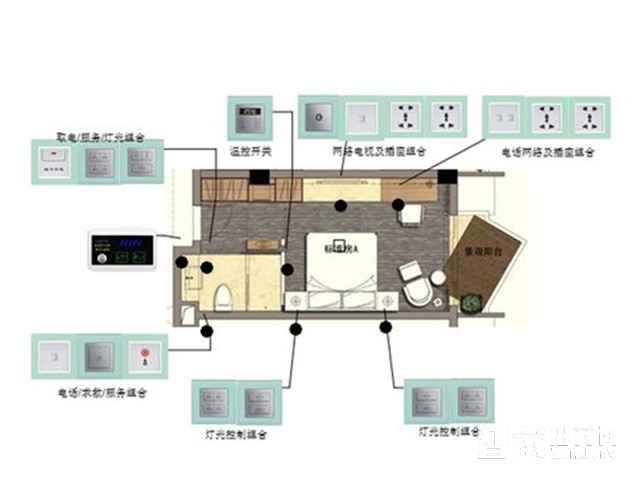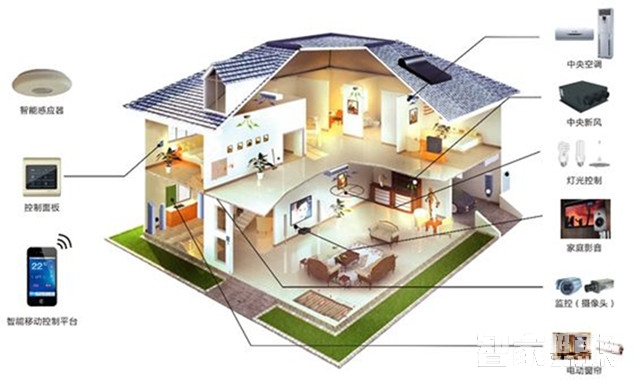With the arrival of the information age, the wave of home intelligence has gradually emerged and the scope of home wiring has expanded a lot. At present, smart homes are divided according to wiring methods. There are mainly three technologies: centralized control, field bus, and wireless mode. Here's a detailed introduction to these control technologies.

1, field bus technology
Fieldbus control system through the system bus to achieve home lighting, electrical appliances and alarm system networking and signal transmission, the use of decentralized field control technology, the control of the network within the various functional modules only need to access the bus to the nearest, wiring more convenient.
In general, the fieldbus class supports the routing of any topology, that is, support for star and ring structure routing. The wiring of strong circuits such as lighting circuits and outlet circuits is completely consistent with the traditional wiring. "One light and more control" is more common in home applications. In the past, it was generally implemented using "double-connected" and "quadruple" switches. The wiring is complicated and the wiring cost is high. If bus control is used, additional wiring is not required at all. Is a fully distributed intelligent control network technology, its product module has two-way communication capabilities, as well as interoperability and interchangeability, and its control components can be programmed. The typical bus technology uses a twisted pair bus structure. Each network node can obtain the power (24V/DC) from the bus. It also realizes the interconnection and communication between nodes with no polarity, no topological logic, and signal transmission rate through the same bus. The system capacity is 10KBPS and 4G respectively.
The fieldbus control system adopts a bus-type structure, which is mainly composed of three basic parts: a power supply, a twisted pair, and a functional module. Each functional module is connected in series on the twisted pair, and the mutual connection is not polarity. The bus control system can be divided into many types from the function, the following will introduce several commonly used:
(1) Basic control, including bus power supply, wireless remote control interface, telephone remote control interface, computer control interface, Ethernet (TCP/IP) interface, security control and security alarm interface, etc. These are the basis of the bus control system. It also provides an interface platform for other bus control products.
(2) Light control, represented by light touch electronic switches/regulators. One characteristic of this type of product is that its appearance size is similar to that of a normal switch. It can directly replace the original switch to realize the intelligent transformation of the lighting system, which can be dimmed or remotely controlled, and can also be used to generate different light combinations. To meet different lighting needs. In case one electronic switch is faulty, the affected part is only the part to which the switch is connected. Even if there is no backup, the original switch can be replaced and the original function can be restored to achieve manual operation.
(3) Electrical control, this type of product is the controllable socket mentioned above. Similar to electronic switches and dimmers, this class can also realize intelligent transformation of electrical appliances by directly replacing the original socket. The power of rice cookers, water heaters, washing machines and other electrical appliances is connected to the outlet. Users can control these appliances through electronic switches, remote controls, or telephones, which is very convenient. The controllable socket is divided into two kinds of automatic and manual operation modes. If the system fails, it can also be manually operated.
(4) Infrared control, which is mainly used to control home appliances such as air conditioners, television sets, DVD players, etc., which are equipped with infrared remote controllers. It has infrared signal learning and memory functions and can be connected to devices on the control bus ( Including the control panel, timing, remote control, telephone, Internet, etc.) to achieve the operation of the air conditioner on, off, mode, temperature, and on the TV, DVD on / off, volume adjustment, channel selection, playback, stop and other operations .
(5) Security control, this category mainly includes human body infrared sensors, gas leak sensors, smoke fire sensors and three tables automatic meter reading and video intercom systems. These are simpler to install and use than others, because there is a bus-compatible flag that can be connected directly to the bus and can be remotely alarmed using the telephone remote/IP interface and other alarm interfaces in the basic system. In addition, ordinary sensors can also be used in the bus system through the security control interface in the basic system.
Talk about the current smart home wiring ways
2, centralized control technology
The smart home system adopting the centralized control method is mainly constructed by a system host with a single-chip microcomputer as its core. The central processing unit (CPU) is responsible for signal processing of the system, and the system main board integrates some peripheral interface units, including security alarms and telephone modules. , control circuit input / output (I / 0) module and other circuits.
This kind of centralized control system host board generally has 8 lights, electrical control loops, 8 alarm signal inputs, 3-4 channel meter reading signals and so on. Due to system capacity limitations, it is difficult to expand and add control loops once the system is installed.
Due to the use of star-type cabling, all security alarm probes, lighting, and electrical control loops must be connected to the main control box. Compared with traditional indoor cabling, the length of the cabling is increased and the cabling is complicated. There are more such products on the market today.
3, wireless communication technology
The current wireless smart home systems mainly include:
1. Star connection
2, bus connection
3, power line carrier connection
4, infrared connection (IR)
5, wireless (RF) connection

Which kind of wiring is best?
First, from the perspective of stability. The star connection is the most stable and reliable, the bus connection is next, the power line carrier connection is again, the infrared connection (IR) is again, and the wireless (RF) connection is the worst. Traditional security systems use star connections and are therefore the most reliable.
Although the bus connection also needs to be wired, when the number of points is larger, the number of connections is smaller than that of the star type, and its reliable line is generally acceptable. There are similar problems in power line carrier and wireless connection. The main problem is the interference between adjacent homes. From the technical point of view, power line carriers can use isolation and other technologies to solve the problem of mutual interference. The wireless mode needs to be solved at low cost. Inter-frequency interference is relatively difficult. Generally, only frequency hopping technology can be used to solve the problem. In addition, there are wireless power supply issues. Therefore, wireless should be a secondary solution in home intelligence, especially security systems.
Second, from the perspective of market issues. There are three markets for home intelligence: the new residential community market, the personal home improvement market, and the old home renovation market.
Newly built residential areas are generally based on residential units, requiring networked alarms and information interaction. The realization of intelligence in the construction of the wiring requirements should not be the first priority for the complexity of the wiring, but with reliability as the first requirement. The intelligence of a whole community, even if there is a problem, is the total number of problems multiplied by the number of households. Realizing family intelligence in the community is generally not too complex to implement, otherwise acceptance and maintenance will be big problems. Therefore, the realization of intelligence in the community should be based on star connections. The personal home improvement market requires more personalized home intelligence features, but no networking requirements. Since personal home improvement is generally promoted by a decoration company and the sales that can be achieved are relatively high, the functional requirements for home interiors are generally more, and the number of points achieved is correspondingly higher. At this time, there are also requirements for the reliability of the system as well as scalability requirements. Since the wiring is not a big problem at this time, the home improvement market should adopt both star and bus methods. The transformation of the market for old homes generally requires a minimum of cabling as a priority. At this time, star-type and bus-type wiring methods are sometimes ineffective. Therefore, power line carrier and wireless should be the main connection method in the transformation of old homes.
Third, as an actual family intelligent system, the best solution should be a variety of wiring schemes that can be mixed and used.
For example, security uses star connection as much as possible, but it can also be supplemented by bus or wireless. Power line carrier is difficult to use for security probe connection because it can't solve the problem of signal transmission during power outage. Star connection is also the best solution for information cabling. Lighting and electrical appliances other than information appliances such as air conditioners, rice cookers, etc. can be controlled by bus, power line, wireless or infrared.
related suggestion:
Article: How to wire the smart home? Smart home wiring strategy analysis
Recommended: health monitoring products security franchise store Rongshida robot
The Anti-explosion Screen Protector is a Screen Protector that can effectively buffer impact, prevent the screen from bursting, or prevent the glass panel from breaking and falling apart due to accidental impact of the mobile phone. It has gloss, texture and surface hardness. The Explosion-proof Screen Protector strengthens the screen and reduces the chance of cracking, broken tempered glass is no longer frequently replaced.
Compared with other Screen Protectors, Explosion-proof Screen Protectors have the following advantages:
1. Anti-shattering: The PET material of the Explosion-proof Screen Protective Film has high strength, flexibility and elasticity, can fully decompose the impact force, and can effectively prevent the screen from being broken or damaged when the screen is impacted or dropped by external forces.
2. HD Clear: The Explosion-proof Screen Protector is made of high-quality PET material, which can maintain a high-definition screen display effect and truly display the original screen color.
3. Anti-fingerprint: The Anti-explosion Screen Protector has a built-in oleophobic and waterproof coating to prevent fingerprints and stains on the phone screen, providing your phone with original texture and perfect touch screen response speed.
The use of an Explosion-proof Anti-explosion Screen Protector can effectively enhance the durability and protection of the mobile phone screen, reduce the risk of screen cracking and damage, and at the same time protect the clarity and quality of the screen display. Ideal for protecting your screen.
PET Screen Protector, Explosion-proof Screen Protector, Explosion-proof Screen Protective Film, Explosion-proof Protective Film,Anti-explosion Screen Protector
Shenzhen Jianjiantong Technology Co., Ltd. , https://www.jjtscreenprotector.com